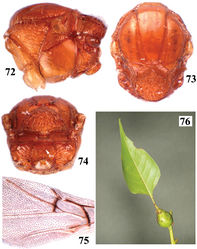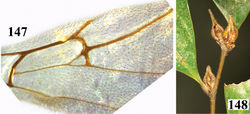Dryocosmus quadripetiolus
| Notice: | This page is derived from the original publication listed below, whose author(s) should always be credited. Further contributors may edit and improve the content of this page and, consequently, need to be credited as well (see page history). Any assessment of factual correctness requires a careful review of the original article as well as of subsequent contributions.
If you are uncertain whether your planned contribution is correct or not, we suggest that you use the associated discussion page instead of editing the page directly. This page should be cited as follows (rationale):
Citation formats to copy and paste
BibTeX: @article{Tang2016JournalofHymenopteraResearch, RIS/ Endnote: TY - JOUR Wikipedia/ Citizendium: <ref name="Tang2016Journal of Hymenoptera Research">{{Citation See also the citation download page at the journal. |
Ordo: Hymenoptera
Familia: Cynipidae
Genus: Dryocosmus
Name
Dryocosmus quadripetiolus Schwéger & Tang sp. n. – Wikispecies link – ZooBank link – Pensoft Profile
Type material
HOLOTYPE female: CHINA: Yunnan Prov., Lan Cang Co., Foufang quarry, ex Castanopsis echinocarpa, 11.IV.2011 (CHI38), 22.593300°N, 99.982633°E, 1625m, ex bird head shaped gall with ridges (AGWP-Morpho74), em. 11.IV.2011, leg. C. T. Tang, F. Sinclair, J. Hearn. One female PARATYPE with the same labels as the holotype.
The female holotype is deposited in NMNS, the female paratype in PHMB.
Etymology
Named after the shape of the gall, which has four petiole-like ridges.
Diagnosis
In Dryocosmus quadripetiolus the mesopleuron is densely setose ventral to the transepisternal line (Fig. 142), while in all other species the mesopleuron is glabrous or with few setae present along the margin of the lateral mesopleural face (Figs 24, 40, 72, 166).
Description
Sexual female: Head color: Head black, except for lighter clypeus; mandibles, maxillary and labial palps yellowish brown; scape and pedicel yellow, flagellomeres progressively darker till last one. Mesosoma and metasoma color: mesosoma black, except for lighter tegula; metasoma dark brown; legs yellowish. Head sculpture: coriaceous. Head shape anterior view: NOT CODED. Head width / head length: 2.10. Head width / head height: 1.20. Head width / maximum mesosoma width: <1. Gena sculpture: coriaceous. Gena reflectivity: matt. Gena length / eye width: 0.50. Gena shape: broadened posterior to eye, visible in frontal view. Malar striae count: present. Malar striae dorsal limit: torulus-eye line on lower face and lower eye margin on malar area. Malar area: alutaceous. Malar sulcus: absent. Eye height / malar distance: 3.33. Inner margins of eyes: NOT CODED. Median ocellus shape: NOT CODED. Lateral ocellus shape: NOT CODED. POL / OOL: 1.50. OOL / diameter of lateral ocellus: 1.80. OOL / LOL: 1.40. Diameter of lateral ocellus / diameter of median ocellus: >1. Transfacial distance / eye height: 1.10. Diameter of torulus / intertorular distance: 1.80. Intertorular distance / eye torulus distance: NOT CODED. Eye-torulus distance / diameter of torulus: 1.20. Lower face sculpture: alutaceous. Lower face pilosity color: white. Lower face pilosity density: NOT CODED. Clypeus convexity: flat. Clypeus sculpture: NOT CODED. Clypeus ventral margin shape: straight. Clypeus reflectivity: NOT CODED. Clypeus shape anterior view: rectangular. Clypeus pilosity: NOT CODED. Clypeus pilosity density: NOT CODED. Clypeus pilosity color: NOT CODED. Anterior tentorial pit: large, distinct. Epistomal sulcus: distinct. Clypeo-pleurostomal line: distinct. Frons sculpture: coriaceous with irregular rugae between lateral ocellus and compound eye. Frons pilosity density: NOT CODED. Frons reflectivity: matt. Frons pilosity color: NOT CODED. Impression around central ocellus: present. Interocellar area sculpture: coriaceous. Interocellar area pilosity density: rare. Interocellar area reflectivity: matt. Interocellar area pilosity color: white. Vertex sculpture: coriaceous. Vertex pilosity density: rare. Vertex reflectivity: matt. Vertex pilosity color: white. Occiput sculpture: coriaceous. Occiput pilosity density: rare. Occiput reflectivity: matt. Occiput pilosity color: white. Postocciput sculpture: coriaceous. Postocciput reflectivity: matt. Postocciput pilosity: present. Postocciput pilosity density: rare. Postocciput pilosity color: white. Median impression of postocciput dorsal to occipital foramen: present. Posterior tentorial pit: distinct, ovate, deep. Impression abjacent ventrally to posterior tentorial pit: present. Postgena sculpture: alutaceous with few delicate rugae medially. Postgena reflectivity: glossy. Postgena pilosity color: white. Postgena pilosity density: dense. Postgena pilosity count: absent medially, present laterally. Postgenal bridge / height of occipital foramen: 1. Postgenal bridge / length of oral foramen: <1. Postgenal bridge sculpture: NOT CODED. Number of flagellomeres (female): 13. Antenna length / body length: <1. Pedicel length / pedicel width: 1.40. Pedicel length / length of broadened part of scape: NOT CODED. Combined length of scape and pedicel / first flagellomere length: NOT CODED. F1 length / F2 length: 1.18. F1 length / pedicel length: 2.25. F1 length / F3 length: NOT CODED. Flagellomeres relative length: F3>F4>F5>F6>F7>F8>F9>F10>F11>F12. F4–F7 relative length: NOT CODED. F3 length/F2 length: NOT CODED. F3 length / F4 length: NOT CODED. F8 length / F7 length: NOT CODED. F9 length /F8 length: NOT CODED. F10 length / F9 length: NOT CODED. F9–F11 relative length: NOT CODED. F10 length / F11 length: NOT CODED. F12 length / F11 length: NOT CODED. F13 length / F12 length: 2. Placoid sensilla present on: F2–F13.
Mesosoma length lateral view / mesosoma height lateral view: 1.2. Pronotum sculpture: alutaceous with some rugae laterally. Pronotal dorsal row of setae count: present. Transverse pronotal sulcus depth: deep. Transverse pronotal sulcus sculpture: NOT CODED. Mesoscutum sculpture: smooth. Mesoscutum reflectivity: glossy. Adnotaular setae: present anteriorly. Mesoscutum length / transscutal line: 1.1. Notaulus limits: well-impressed, posterior end adjacent to posterior margin of mesoscutum, anterior end adjacent to anterior margin of mesoscutum. Notaulus sculpture: NOT CODED. Notaulus posterior region width / anterior region width: NOT CODED. Mesoscutal suprahumeral sulcus anterior end vs notaulus anterior end: adjacent. Mesoscutal suprahumeral sulcus sculpture: NOT CODED. Median mesoscutal line: absent. Median mesoscutal line shape: NOT CODED. Parapsidal line: present. Parapsidal line distinctness: indistinct. Anteroadmedian line: present. Antero-admedian line length / mesoscutum median length: 0.25. Dorsomedian area of mesoscutellar-axillar complex (disc of mesoscutellum+axillar foveae): coriaceous, foveolate laterally and posteriorly. Dorsomedian area of mesoscutellar-axillar complex (disc of mesoscutellum+axillar foveae) shape: trapezoid. Dorsomedian area of mesoscutellar-axillar complex (disc of mesoscutellum+axillar foveae) pilosity color: white. Dorsomedian area of mesoscutellar-axillar complex (disc of mesoscutellum+axillar foveae) pilosity density: rare. Mesoscutellar axillar complex posterior margin vs metanotum: overhanging. Mesoscutellar-axillar complex length / mesoscutellar disc width: >1. Disc of mesoscutellum sculpture: rugose. Disc of mesoscutellum maximum width: in posterior 1/3. Scutellar fovea sculpture: smooth with longitudinal, parallel rugae. Scutellar fovea shape: semilunar. Scutellar fovea reflectivity: glossy. Foveal septum: absent. Anterior pits on foveal septum: NOT CODED. Scutellar fovea maximum diameter / scutellar fovea minimum diameter: 1.7. Scutellar fovea minimum diameter / foveal septum width: NOT CODED. Postacetabular suclus count: NOT CODED. Mesopleuron sculpture: smooth, transepisternal line is marked by few delicate sulci, area dorsal to transepisternal line smooth. Mesopleuron reflectivity: glossy. Mesopleuron pilosity: dense setae present just ventral to transepisternal line. Speculum sculpture: smooth. Speculum reflectivity: glossy. Mesopleural triangle sculpture: coriaceous. Mesopleural triangle reflectivity: NOT CODED. Mesopleural triangle pilosity: NOT CODED. Mesopleural triangle pilosity color: NOT CODED. Mesopleural trinagle pilosity density: NOT CODED. Dorsoaxillar area sculpture: alutaceous with few rugae. Dorsoaxillar area reflectivity: NOT CODED. Dorsoaxillar area pilosity color: NOT CODED. Dorsoaxillar area pilosity density: NOT CODED. Lateroaxillar area sculpture: alutaceous with few rugae. Lateroaxillar area reflectivity: NOT CODED. Lateroaxillar area pilosity density: NOT CODED. Lateroaxillar area pilosity color: NOT CODED. Subaxillular bar sculpture: smooth. Subaxillular bar reflectivity: glossy. Posterior height of subaxillular bar / height of metanotal trough: 1.27. Metapleural sulcus anterior end: reaches mesometapleural suture in upper 1/4 of its length. Metascutellum sculpture: coriaceous. Metanotal trough sculpture: smooth. Metanotal trough reflectivity: glossy. Metanotal trough pilosity: absent. Metanotal trough pilosity density: NOT CODED. Ventral impressed area of metanotum sculpture: smooth without striae. Metascutellum height / ventral impressed area of metanotum height: 2. Central propodeal area sculpture: smooth with irregular rugae. Central propodeal area reflectivity: glossy. Lateral propodeal carina shape: broad, high, slightly curved laterally in mid-height. Lateral propodeal area sculpture: smooth with irregular rugae. Lateral propodeal area pilosity: present. Lateral propodeal area pilosity color: NOT CODED. Lateral propodeal area pilosity density: dense. Nucha sculpture: with delicate longitudinal rugae dorsally and laterally. Radial cell length / radial cell width: 3.7. Rs+M vs basalis: reaches basalis in lower half of its height. Rs+M color: dark brown. Areolet: large, triangular, conspicuous. Marginal cilia: long. Rs distal end vs wing margin: adjacent to wing margin. R1 distal end vs wing margin: adjacent to wing margin. Basal lobe on metatarsal claw: absent. Basal lobe on tarsal claw shape: NOT CODED.
Metasoma length / head+mesosoma length: <1. Metasoma lateral height / metasoma lateral length: <1. 2nd metasomal tergite length dorsal view / length of metasoma dorsal view: 1/3. Second metasomal tergite pilosity: present mediolaterally. Second metasomal tergite sculpture: smooth. Second metasomal tergite reflectivity: NOT CODED. Second metasomal tergite pilosity density: rare. Metasomal tergites 3–6 sculpture: smooth, no micropunctures. Metasomal tergites 3–6 reflectivity: glossy. Metasomal tergites 3–6 pilosity: absent. Prominent part of ventral spine of hypopygium length ventral view / Prominent part of ventral spine of hypopygium width ventral view: NOT CODED. Hypopygial setae apical end: extending beyond posterior end of ventral spine of hypopygium.
Body length: 2.45 mm (n=2).
Male: Unknown.
Gall (Fig. 148): Galls develop from buds, detachable. The body of the gall contains a subglobose part and a needle-like projection; the subglobose part is 5.0–6.0 mm in diameter, 6.0–7.0 in height; the needle-like projection at the top of the gall body nearly as long as or slightly longer than the height of the subglobose part. The gall body is marked with four longitudinal ribs, pubescent. The mature gall is brownish, similar to the color of the twig. The larval chamber is centrally located at the subglobose part, unilocular.
Biology
Based on the morphology, gall maturation and emergence period of adults, the described females represent the sexual generation. Galls are in buds on Castanopsis echinocarpa. Galls were collected in April and adults emerged from galls under laboratory conditions immediately after field collection.
Distribution
China: Yunnan Province (Lan Cang County).
Original Description
- Tang, C; Mikó, I; Nicholls, J; Schwéger, S; Yang, M; Stone, G; Sinclair, F; Bozsó, M; Melika, G; Pénzes, Z; 2016: New Dryocosmus Giraud species associated with Cyclobalanopsis and non-Quercus host plants from the Eastern Palaearctic (Hymenoptera, Cynipidae, Cynipini) Journal of Hymenoptera Research, (53): 77-162. doi
Images
|






